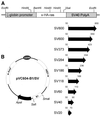Defining the minimal length of sequence homology required for selective gene isolation by TAR cloning
- PMID: 11239009
- PMCID: PMC29761
- DOI: 10.1093/nar/29.6.e32
Defining the minimal length of sequence homology required for selective gene isolation by TAR cloning
Abstract
The transformation-associated recombination (TAR) cloning technique allows selective and accurate isolation of chromosomal regions and genes from complex genomes. The technique is based on in vivo recombination between genomic DNA and a linearized vector containing homologous sequences, or hooks, to the gene of interest. The recombination occurs during transformation of yeast spheroplasts that results in the generation of a yeast artificial chromosome (YAC) containing the gene of interest. To further enhance and refine the TAR cloning technology, we determined the minimal size of a specific hook required for gene isolation utilizing the Tg.AC mouse transgene as a targeted region. For this purpose a set of vectors containing a B1 repeat hook and a Tg.AC-specific hook of variable sizes (from 20 to 800 bp) was constructed and checked for efficiency of transgene isolation by a radial TAR cloning. When vectors with a specific hook that was >/=60 bp were utilized, approximately 2% of transformants contained circular YACs with the Tg.AC transgene sequences. Efficiency of cloning dramatically decreased when the TAR vector contained a hook of 40 bp or less. Thus, the minimal length of a unique sequence required for gene isolation by TAR is approximately 60 bp. No transgene-positive YAC clones were detected when an ARS element was incorporated into a vector, demonstrating that the absence of a yeast origin of replication in a vector is a prerequisite for efficient gene isolation by TAR cloning.
Figures


Similar articles
-
A genetic system for direct selection of gene-positive clones during recombinational cloning in yeast.Nucleic Acids Res. 2002 Jan 15;30(2):E8. doi: 10.1093/nar/30.2.e8. Nucleic Acids Res. 2002. PMID: 11788734 Free PMC article.
-
A general cloning system to selectively isolate any eukaryotic or prokaryotic genomic region in yeast.BMC Genomics. 2003 Apr 29;4(1):16. doi: 10.1186/1471-2164-4-16. Epub 2003 Apr 29. BMC Genomics. 2003. PMID: 12720573 Free PMC article.
-
Construction of human chromosome 16- and 5-specific circular YAC/BAC libraries by in vivo recombination in yeast (TAR cloning).Genomics. 1998 Oct 1;53(1):21-8. doi: 10.1006/geno.1998.5469. Genomics. 1998. PMID: 9787074
-
Selective isolation of mammalian genes by TAR cloning.Curr Protoc Hum Genet. 2006 May;Chapter 5:Unit 5.17. doi: 10.1002/0471142905.hg0517s49. Curr Protoc Hum Genet. 2006. PMID: 18428393 Review.
-
Transformation-associated recombination (TAR) cloning for genomics studies and synthetic biology.Chromosoma. 2016 Sep;125(4):621-32. doi: 10.1007/s00412-016-0588-3. Epub 2016 Apr 26. Chromosoma. 2016. PMID: 27116033 Free PMC article. Review.
Cited by
-
Synthetic Genomics From a Yeast Perspective.Front Bioeng Biotechnol. 2022 Mar 21;10:869486. doi: 10.3389/fbioe.2022.869486. eCollection 2022. Front Bioeng Biotechnol. 2022. PMID: 35387293 Free PMC article. Review.
-
Viral serotype and the transgene sequence influence overlapping adeno-associated viral (AAV) vector-mediated gene transfer in skeletal muscle.J Gene Med. 2006 Mar;8(3):298-305. doi: 10.1002/jgm.835. J Gene Med. 2006. PMID: 16385549 Free PMC article.
-
Transformation-associated recombination (TAR) cloning and its applications for gene function; genome architecture and evolution; biotechnology and biomedicine.Oncotarget. 2023 Dec 22;14:1009-1033. doi: 10.18632/oncotarget.28546. Oncotarget. 2023. PMID: 38147065 Free PMC article. Review.
-
PCR-Independent Method of Transformation-Associated Recombination Reveals the Cosmomycin Biosynthetic Gene Cluster in an Ocean Streptomycete.J Nat Prod. 2017 Apr 28;80(4):1200-1204. doi: 10.1021/acs.jnatprod.6b01121. Epub 2017 Mar 23. J Nat Prod. 2017. PMID: 28333450 Free PMC article.
-
Assembly of ascovirus HvAV-3h long DNA fragment using the Transformation-Associated Recombination (TAR) approach in yeast cells.BMC Biotechnol. 2025 May 22;25(1):42. doi: 10.1186/s12896-025-00964-8. BMC Biotechnol. 2025. PMID: 40405135 Free PMC article.
References
-
- Kouprina N. and Larionov,V. (1999) Selective isolation of mammalian genes by TAR cloning. In Boyle,A.L. (ed.), Current Protocols in Human Genetics. John Wiley and Sons, New York, NY, Vol. 1, pp. 5.17.1–5.17.21. - PubMed
MeSH terms
Substances
LinkOut - more resources
Full Text Sources
Other Literature Sources
Miscellaneous

